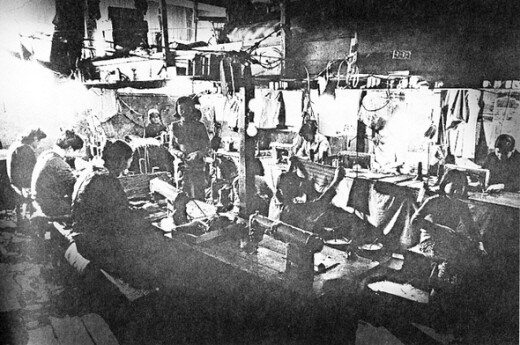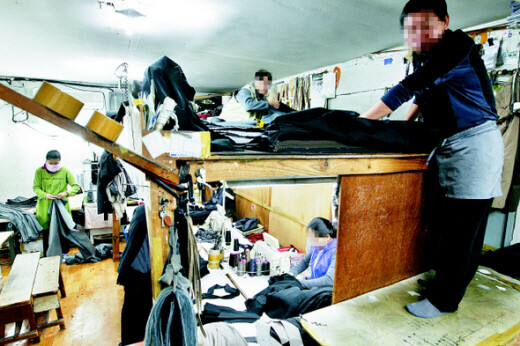hankyoreh
Links to other country sites 다른 나라 사이트 링크
Decades later, faces change while poor conditions linger at sewing factories


By Son Jun-hyun, Senior Staff Writer
“Clothing manufacturer looking for seamstress” “Looking for temporary worker for subcontract garment cutting work”
Throughout the Changsin neighborhood of Seoul’s Jongno District, there are help-wanted ads for sewing factories. Some 40 years ago, Chun Tae-il used the 30 Won ($.03) bus fair to buy 1 Won snacks for the young female seamstresses, while he walked from the Pyeonghwa Market on Cheonggyecheon 6-ga through Changsin neighborhood to Ssangmun neighborhood.
We open the door to the basement floor of a family home near Changsin 2-dong Community Center, and there is the faint “factory light.” Sewing machines are humming along like they did 40 years ago. Six women - three Koreans, one Vietnamese, one Vietnamese married to a Korean and one Nepalese - are working in this factory, which is in the loft. Ms. Oh (57), an employee, says the working environment is still poor, although it is better than it was in the 1970s, when one floor would be split into two. She said it was fortunate that they would soon install a dust remover and a fan.
You can no longer find junior seamstresses hunched over their machines under a misty light like in the old days. Instead, you find women in their 30s and 40s and migrant laborers sitting in front of the machines. The migrant laborers wave at the camera. The owner, Mr. Kim (55), said he frequently has to close the shop when immigration officers crack down on his three or four foreign laborers at the same time. He said to pay the fine, 2 million Won per person for a total of 6 million Won, he has to take from his security deposit, and with no workforce, he has no choice but to close.
Clothing wholesalers and retailers began entering the Cheonggyecheon area with the foundation of the Pyeonghwa Market in 1961. After this, the Sinpyeonghwa and Donghwa Markets (1969), the Heungin Market (1976), Gwanghui Market (1980) and Dongpyeonghwa and Cheongpyeonghwa Markets (1983) entered, and the Cheongyecheon of today became the center of the large-scale clothing industry. The sewing factories that were concentrated in the Pyeonghwa Market when Chun set himself on fire began moving out quickly from the early 1980s; now they are concentrated in Changsin neighborhood, Sungin neighborhood, Ihwa neighborhood, Sindang neighborhood and Wangsimni.
The working environment was relatively clean on the second-floor factory in an arcade building in Changsin neighborhood. All of its roughly 10 employees were Korean. We asked Kim Jeong-sun (42), a seamstress here, whether she knew Chun Tae-il. She said she has heard the name, but she did not know much about him. Garment cutter Chun’s death by self-immolation on November 13, 1970, became a watershed in modern Korean intellectual history.
Garnment cutters earn a modest 2.5 million Won ($2,233) per month, seamstresses, usually subcontracted, make about 1.7 to 1.8 million Won, and assistant seamstresses make 1.1 to 1.5 million Won. In the alleys, motorcycles busily deliver fabric. The owner of a local supermarket said the local economy is good only if there are an abundance of motorcycles driving around.
There are few statistics as most are petty businesses without business registration numbers, but the industry estimates that there are about 3,000 sewing factories in Changsin 1, 2 and 3-dong neighborhoods. It is common to find three or four factories in a two-story building with a basement.
The sewing industry is currently making efforts to develop itself. Cha Gyeong-nam of the Clothing Sewing Support Center, created by firms in the industry, said 30 workplaces in Changsin and Sungin neighborhood received 2 million Won each in support from Seoul City this year to improve the work environment, including dust removers. He added that petty businesses must now register their businesses and form corporations by merging several places together.
Please direct questions or comments to [englishhani@hani.co.kr]
Editorial・opinion
![[Column] Has Korea, too, crossed the Rubicon on China? [Column] Has Korea, too, crossed the Rubicon on China?](https://flexible.img.hani.co.kr/flexible/normal/500/300/imgdb/original/2024/0419/9317135153409185.jpg) [Column] Has Korea, too, crossed the Rubicon on China?
[Column] Has Korea, too, crossed the Rubicon on China?![[Correspondent’s column] In Japan’s alliance with US, echoes of its past alliances with UK [Correspondent’s column] In Japan’s alliance with US, echoes of its past alliances with UK](https://flexible.img.hani.co.kr/flexible/normal/500/300/imgdb/original/2024/0419/2317135166563519.jpg) [Correspondent’s column] In Japan’s alliance with US, echoes of its past alliances with UK
[Correspondent’s column] In Japan’s alliance with US, echoes of its past alliances with UK- [Editorial] Does Yoon think the Korean public is wrong?
- [Editorial] As it bolsters its alliance with US, Japan must be accountable for past
- [Guest essay] Amending the Constitution is Yoon’s key to leaving office in public’s good graces
- [Editorial] 10 years on, lessons of Sewol tragedy must never be forgotten
- [Column] A death blow to Korea’s prosecutor politics
- [Correspondent’s column] The US and the end of Japanese pacifism
- [Guest essay] How Korea turned its trainee doctors into monsters
- [Guest essay] As someone who helped forge Seoul-Moscow ties, their status today troubles me
Most viewed articles
- 1[Column] The clock is ticking for Korea’s first lady
- 2After 2 months of delayed, denied medical care, Koreans worry worst may be yet to come
- 3[Column] Has Korea, too, crossed the Rubicon on China?
- 4Hong Se-hwa, voice for tolerance whose memoir of exile touched a chord, dies at 76
- 5US overtakes China as Korea’s top export market, prompting trade sanction jitters
- 6[Correspondent’s column] In Japan’s alliance with US, echoes of its past alliances with UK
- 7All eyes on Xiaomi after it pulls off EV that Apple couldn’t
- 8[News analysis] After elections, prosecutorial reform will likely make legislative agenda
- 9Samsung barricades office as unionized workers strike for better conditions
- 10More South Koreans, particularly the young, are leaving their religions